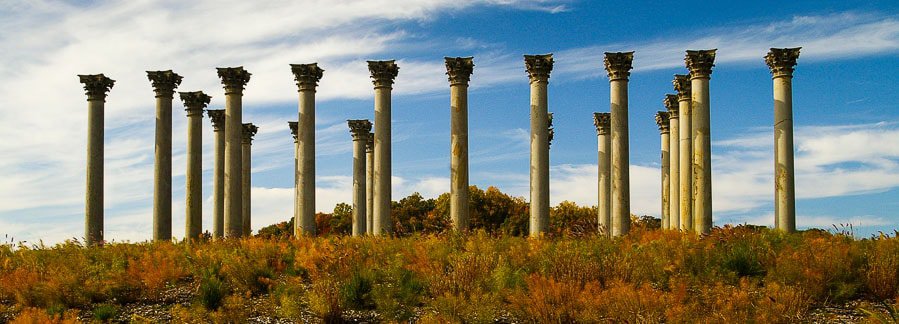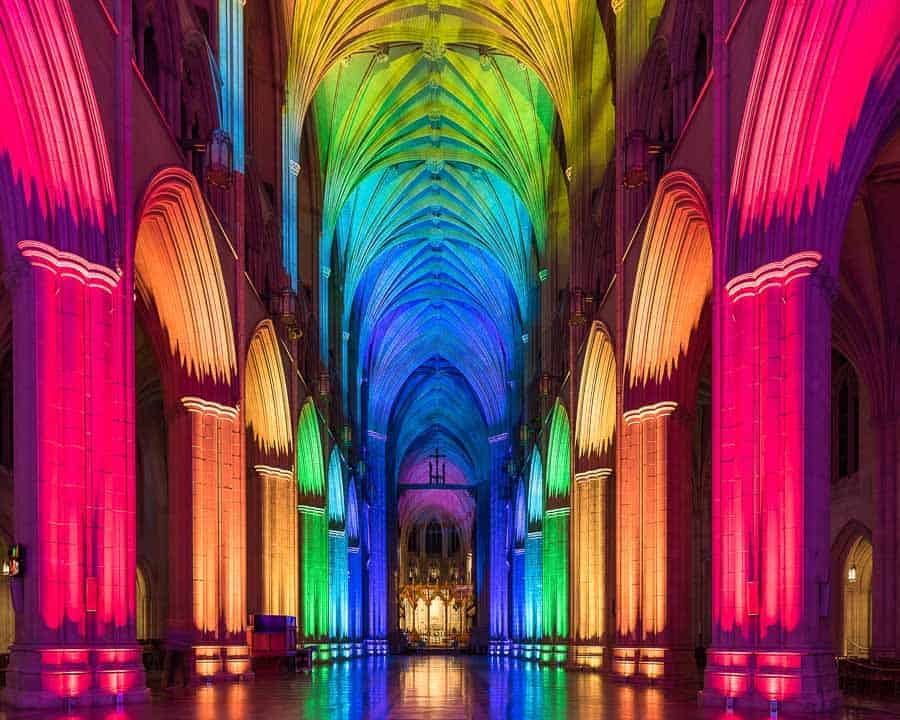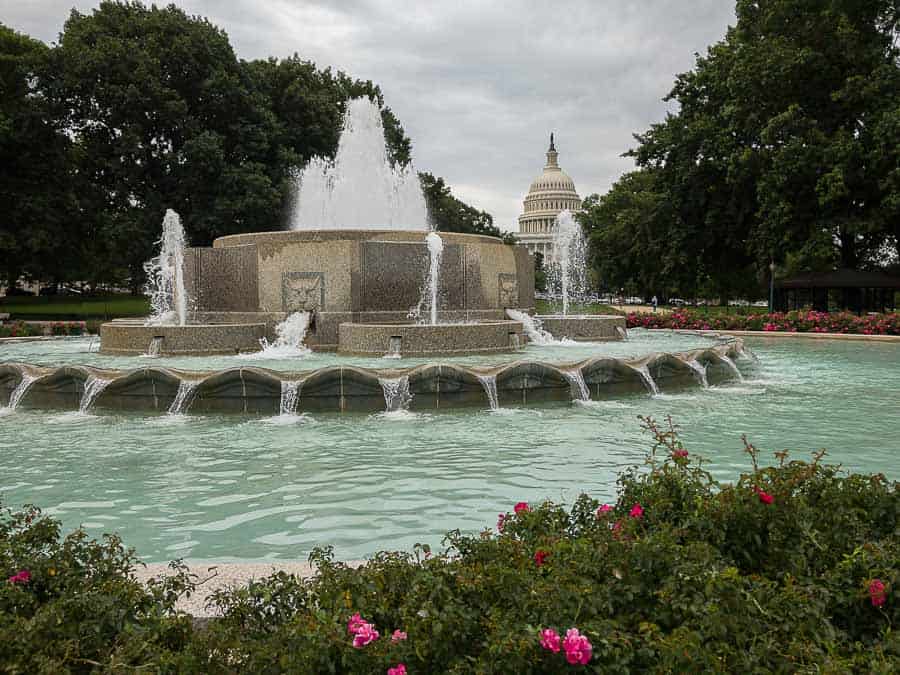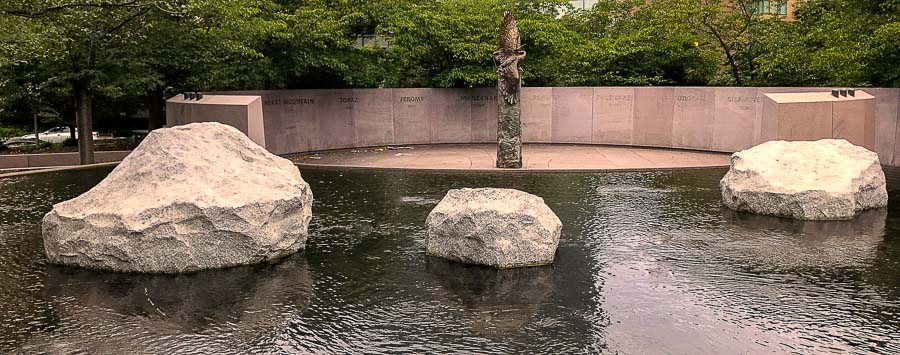Hello and welcome to Washington, DC! I was born here and love this town. As a visitor, of course you’ll take the typical shots of the monuments, government buildings, zoo and museums! But, if you want to get away from the hordes of selfie-stick-toting tourists, here are some of my favorite off-the-beaten-path photo locations.
Because it's my list, it's subjective and by no means comprehensive. I love the iconic shots as much as anyone, but I also like getting far from the madding crowd and finding interesting sights and neighborhoods. The customized Google map (shown above) will help you locate them.
Each of these locations is within DC or directly across the river in Arlington (spots in the nearby suburbs merit an article of their own). Some of these spots are interesting buildings, some are natural areas and gardens, and some are vantage points. Some are reachable by public transit and some require a car. Quite a few are near popular tourist destinations, but don’t get the same amount of traffic. Many are also found in Improve Photography’s Really Good Photo Spots app (rGPS). The rest will wind up there, once I get my butt up and away from a desk and out shooting again!
While this list is specific to Washington, DC, you could use it as a guide to finding similar places in almost any large city. Most will have their own iconic and little-known parks and statues, churches and vistas, unique neighborhoods and locations for street photography. The trick is to find the ones to which most tourists don’t go.
Note that commercial photography in National Parks or on federal property requires a permit and some crowded areas like the Vietnam Veterans Memorial or places with security concerns like the US Capitol Building prohibit tripods.
NATURE
National Arboretum (rGPS)
Off New York Avenue in the Northeast quadrant of DC lies the National Arboretum, almost 450 acres of gardens and plants. Hillsides of azaleas, a collection of bonsai trees, a classical Chinese garden, a koi pond and miles of roads and walking paths that crisscross the Arboretum. Near the center of the property stand 22 Corinthian columns that were originally part of the east front of the US Capitol building. They were removed during a late 1950s remodeling of the Capitol and erected here in the 1980s. Standing in a meadow, they generally get good morning and late afternoon light. You’ll need a car to get here but, unless it’s a pleasant weekend day or during the azalea bloom, you’ll not see crowds of tourists.

Rock Creek Park, Boulders Section
If you’re at the National Zoo, you’re not far from another, lesser known scenic site. Rock Creek runs through the northwest quadrant of the city, past the Zoo, and empties into the Potomac near Georgetown. Established as a park in 1890 and designed, in part, by Frederick Law Olmstead, it includes woodlands and meadows, massive bridges where Beach Drive goes under Connecticut Avenue and Calvert Street, hiking trails and picnic areas. My favorite part is the Boulders or Rapids Section, a one-mile stretch where the creek flows through a small gorge that has deposited large boulders in the streambed. This section is closed to vehicular traffic on weekends, requiring you to walk in from a parking area off Broad Branch Road at Beach Drive. Beach Drive mostly follows the east bank of the creek and a hiking trail skirts the west bank. This is best early in the morning or late in the afternoon (or on a cloudy day) when there is not a strong contrast between sunlight and shadow. The vibrant greens of Spring or orange-yellows of Autumn are particularly beautiful times of year to photograph here. I like shooting from the area around the Rapids Bridge, but the Boulder Bridge can also make a nice composition.

Theodore Roosevelt Island
A quiet nature refuge in the city. Reachable by footbridge from a parking lot off the outbound George Washington Parkway or via the Mount Vernon Trail from the Rosslyn Metro Station, Roosevelt Island is an 88 acre sanctuary in the middle of the Potomac River. There are miles of trails through the woods, a plaza with a statue of TR and nice views of the Kennedy Center across the channel and the Francis Scott Key Bridge upstream. You might also get kayaks, canoes and racing sculls on the water. Roosevelt Island also has a wide variety of wildflowers in the spring, birds, turtles, and frogs.
SCUPTURES & STATUES
Albert Einstein Memorial
When you’re visiting the Lincoln and Vietnam Veterans Memorials, go across Constitution Avenue to the Albert Einstein Memorial, a charming, larger-than-life statue of the scientist on the grounds of the National Academy of Science. The seated statue often draws passersby to sit and relax, or mimic the pose. The National Academy even sponsors an Instagram, #photoswithalbert, where you can post your own shot. Note the green marble slabs at the statue’s base, which are embedded with metal studs showing the position of the stars on the day the statue was dedicated. Shadows and light can be harsh here during mid-day. Best times are on overcast days or in the morning, when the statue catches the sun. It’s one of many monumental statues (there are two on the same block as my office!) scattered about town, but one of my favorites.

National Gallery of Art Sculpture Garden
Less well known than the Hirshhorn Sculpture Garden across the Mall, the garden of the National Gallery of Art has a playful variety of artworks, from a giant typewriter eraser by Claes Oldenburg to an optical illusion of a house by Roy Lichtenstein to an art nouveau entrance from the Paris Metro. In addition to the sculptures, there is a fountain in the 6 acre park that is turned into an ice skating rink in the winter. It’s also a good spot for people watching, especially when there’s live music in the park. It’s located between 7th and 9th Street, across Pennsylvania Avenue from the National Archives. Try framing one of the sculptures with the Archives or museums on the Mall. Archives Metro Station is across Pennsylvania Avenue.
The Adams Memorial

In Rock Creek Cemetery, across from the Lincoln Cottage at the Old Soldiers Home, is a moving and mysterious statue marking the graves of Henry and Clover Adams. Created by August St. Gaudens, the enigmatic statue, popularly known as “Grief”, actually reflects the Buddhist idea of nirvana, but is open to interpretation. The setting, designed by noted architect Sanford White is surrounded by yew trees. A number of other well-known individuals are buried in the cemetery, including writers Upton Sinclair and Gore Vidal. Elaborate monuments, mausoleums and sculptures are dotted around the peaceful grounds, including the Rabboni-Ffoulke Memorial by Gutzon Borglum, the sculptor who created Mount Rushmore.
If you like shooting cemeteries, Congressional Cemetery in Southeast is worth your while. Among those buried here are former FBI Director J. Edgar Hoover, Civil War-era photographer Matthew Brady, musician and composer John Philip Sousa, and Elbridge Gerry, Vice President under James Madison and after whom the term “gerrymandering” was coined. Many Members of Congress were buried there in the early 1800s, their graves marked by a series of more than 150 identical cenotaphs, laid out in neat rows. A few blocks east of the Potomac Avenue Metro on G Street.
VIEWS
Old Post Office Bell Tower
With the Washington Monument closed for repairs until the Spring of 2019, where else can you get a bird’s eye view of the city? You may be surprised to find it at what is now the Trump Hotel at the Old Post Office Pavilion. Built in the 1890’s the building is actually owned by the federal government and leased to the hotel, but the clock tower is operated by the National Park Service. Open from 9 AM to 5 PM daily (except Thanksgiving and Christmas), you can take an elevator up to the 12th floor observation deck for a panoramic view of the city. Enter through the door near the Starbucks on 12th Street, just south of Pennsylvania Avenue. Federal Triangle Metro.
In the same area, the architecture of Federal Triangle, across 12th Street, reminds me of Paris. The curved colonnade has interesting shadows in the late morning or early afternoon.

Netherlands Carillion (“DC Trifecta” in the rGPS app)
Where is a scenic overview of the city? Where can you get the best view of the iconic buildings? Next to the US Marine Corps War Memorial (the “Iwo Jima Memorial”) stands the Netherlands Carillon, a large modern bell tower. From right in front of the carillon, you have a view across the Potomac River right down the National Mall where the Lincoln Memorial, Washington Monument and US Capitol Dome all line up for a cool telephoto shot. From here, you’re looking almost due east, so you can shoot sunrise over the Capitol or see the monuments bathed in golden light towards sunset. A few times a year, the full moon rises behind the Capitol. And, of course, you can shoot the Marine Corps Memorial. If you’re up there after sunset, try playing with your White Balance settings as you zoom in to capture details of the statues. Tungsten setting, for example, gives the figures a cool, blue cast that’s neat. Limited parking at the Marine Corps Memorial.
For another great view of the city, see the Tower Climb tour at the Washington National Cathedral, below. The Cathedral was built the highest ground in the District and its 301 foot bell tower is the highest point in the city, giving it commanding view of the area.
BUILDINGS
Kogod Courtyard
If you find yourself in the Gallery Place – Chinatown area, by all means photograph the arch on H Street at 7th. Then mosey inside the National Portrait Gallery/Museum of American Art. The galleries of these paired Smithsonian Museums enclose a large central courtyard covered by a remarkable 37,500 square foot glass canopy that’s interesting in its own right, but also casts nifty mid-day shadows on the courtyard. Inside the courtyard are planters, benches and edge fountains. Locals often enjoy lunch here (but avoid the overpriced café) and there are occasional evening events and concerts held in the courtyard. While there, visit the Great Hall on the third floor, a majestic space that was used for Lincoln's second inaugural ball. You'll want your wideest lens here. Gallery Place – Chinatown Metro.
Franciscan Monastery (rGPS)
The Franciscan Monastery of the Holy Land in America is an oasis of calm in the city. With beautiful gardens, especially during the tulip bloom, stained-glass windows and a richly detailed interior, and extensive grounds, the Monastery is one of DC’s hidden gems. Tours of the church, catacombs and Nativity Grotto (lower level of church) are available with many photographic opportunities. No commercial photography without a permit and do be careful not to disturb worshippers.
Washington National Cathedral
The Episcopal Cathedral Church of Sts. Peter and Paul is the second largest cathedral in the US. The Gothic church was only completed in 1990 and is currently undergoing repairs to earthquake damage in 2011. It's hardly hidden or unknown, but many visitors don't know about the special tours or to look for specific details, like gargoyles in the form of a hippie or Darth Vader (you'll need a good telephoto lens!), or the moon rock in the Apollo 11 stained glass window, or the depiction of Halley’s Comet. When the light is right, the stained-glass windows cast colorful patterns on the interior stonework. Even most locals don't know that the Cathedral offers variety of specialty tours with access to behind-the-scenes areas generally off limits to the public. You can climb the 333 steps of the central tower to one of the best views in Washington. High above the ground on Mount St. Albans, on a clear day, you can see all of DC and across the Potomac into Virginia. In addition, there are occasional photography events such as when the nave is cleared of pews and illuminated by rotating colored lights. Check the website for upcoming events or sign up for their e-newsletter.

If you enjoy shooting churches, consider going to the Basilica of the National Shrine of the Immaculate Conception on the grounds of Catholic University in Northeast, or the often overlooked St. Matthews Cathedral near Dupont Circle.
Not into churches? Try shooting the gull-winged roof of the United States Institute of Peace on 23rd Street near the Einstein Statue (above).
PLACES
Dupont Circle
The area around Dupont Circle is ripe with photo possibilities. There’s great people watching around this vibrant neighborhood. Just up Massachusetts Avenue is Embassy Row, with dozens of foreign embassies and consulates in striking buildings. There are several interesting mansions around the Circle and more in the nearby streets. The neighborhood also has a variety of colorful shops and restaurants. The northern Metro entrance is an interesting subject, with escalators going down into a deep semicircular wall inscribed with poetry from Walt Whitman.
A few blocks away, on 22nd Street connecting Decatur and S Streets lie the Spanish Steps, an elegant staircase built in 1911. Worth a detour if you have the time or are visiting the Woodrow Wilson house on S Street. And, if you like steps, the staircase down which Father Damien Karras falls in the movie The Exorcist makes for a spooky shot. Find it at the end of 36th Street at Prospect Street going down to Canal Road.
Other street photography locations are the neighborhood around 14th and U Streets, NW, a vibrant area with great restaurants and clubs, the Lincoln Theater, and lots of colorful people and buildings, and Adams Morgan, near 18th Street and Columbia Road, NW, a polychromatic mixing bowl of cultures and nationalities and food.
PARKS
Upper and Lower Senate Park
You’re going to take the iconic shots of the east and west fronts of the US Capitol Building, but want a different vantage point? Senate Park runs between Union Station and the Capitol and is on top of an underground parking complex for Senators and staff. Use the reflecting pool or fountain to frame your shots of the Capitol or shoot the many flowers and large trees that line the pathways through the park. Television reporters are often seen in the upper part interviewing Senators and using the Capitol as a backdrop. The park runs north-south, so morning and evening or an overcast day are the best times here. Union Station Metro.

While you’re there, walk over to Louisiana Avenue and D Street for the Japanese American Memorial to Patriotism During World War II. With elements of a Zen garden, the memorial invites contemplation and is a different kind of design than most monuments.

Meridian Hill Park
Meridian Hill is a 12 acre park between 15th and 16th Streets that descends from Euclid to W Street, NW. Inside the park, also known as Malcom X Park, is a 13-step cascading waterfall as well as gardens and a mall for performances. Statues in the park range from Joan of Arc and Dante to President James Buchanan. In addition to the fountains, statues and greenery, the park is a good location for people watching and street photography. You never know what you’ll see here!
If formal gardens are your thing, take a look at Hillwood, the former estate of Marjorie Merriweather Post, just outside Rock Creek Park, and at Dumbarton Oaks (closed until March 2018), in Georgetown.
So, that's 25 interesting places to photograph in DC. But, here are a couple of bonus spots for reading this far.
Gravelly Point
If you like airplanes, this is the spot for you! Depending on the wind, aircraft taking off from or landing at National Airport pass right overhead at low altitudes. On a nice day, this site can get crowded with picnickers and families.
Memorial Bridge
If you’re at the Lincoln Memorial or the Korean War Veterans Memorial, walk down to the Potomac River. From the shore here you have a nice shot of the Memorial Bridge going over to Arlington Cemetery and the Custis-Lee Mansion. I think it’s the most beautiful bridge in the DC area and, reflecting morning light, can be spectacular. Especially in the early morning, you can often get one of the college rowing teams slicing through the river. If you’re on the Arlington side of the river, especially in the late afternoon’s golden light, walking upstream just a bit toward Theodore Roosevelt Island nets you a viewpoint with the bridge in the foreground and both the Lincoln Memorial and Washington Monument in the background.
Do you have a favorite place to shoot here in DC? Share your tips in the comments.
Locate these places on a customized Google map (pictured at the head of this article) and do an image search for any that interest you to get a better feel for the possibilities. Then enjoy your time in DC!


Great article! I’ve been wondering where else to take shots beside the usual suspects in the metro area. I live in the MD burbs, but travel through many paths to get to work at the far end of the district.
Glad you found some new spots!
Constitution Gardens is also a wonderful place to capture some great images.
Yes, Constitution Gardens is cool. However, they’ve started a process to dig it up and relandscape it (based on availability of funding) that could last years. First phase involved moving the lockkeepers house. There’s a lot more to come that could make it less appealing for a while. I’ll miss it.
Good to know. I haven’t been there in about 18 months and I am over due. I love wandering the National Mall between 2 and 5AM.
I’ve lived in DC for 20 years and have three more suggestions: Kenilworth Aquatic Gardens in NE D.C.; Arlington National Cemetery; and Great Falls Park, (both the Virginia or Maryland sides have great views of upper Potomac falls.).
Good suggestions Geoff. I was just up at Great Falls a couple of weekends ago. I’ve always liked it but there were thousands of people there around sunset (I was shooting a full moonrise) jostling around the viewpoints. Kenilworth Aquatic Gardens is pretty great when the water lillies and lotus bloom. Are there other things to see and shoot there? And Arlington Cemetery . . . kind of goes without saying. Now, some hidden places in Arlington Cemetery, that would be really interesting. I haven’t spent nearly enough time exploring there.
Nice article Frank!
Thanks, Ed!
Great photos! I was looking for home remodeling photos on your website. Though I never found one yet but this one is excellent.